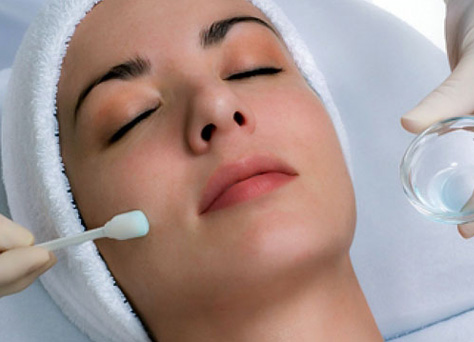 Chemical peeling is the application of a chemical agent of defined strength to the skin that causes destruction at the required depth, followed by remodeling without scarring. Chemical peels are superficial and medium depth peels. Superficial peels are Glycolic peel, Salicylic peel, Mandelic peel , and Lactic peel. Glycolic peel is an all purpose peel, Salicylic peel is antibacterial and keratolytic for pimple prone skin, Mandelic peel for oily and pigmented skin, Lactic peel for dry and sensitive peels. Trchloroacetic peel is medium depth peel used for Acanthosis nigricans, Xanthelasma etc.
Chemical peeling is the application of a chemical agent of defined strength to the skin that causes destruction at the required depth, followed by remodeling without scarring. Chemical peels are superficial and medium depth peels. Superficial peels are Glycolic peel, Salicylic peel, Mandelic peel , and Lactic peel. Glycolic peel is an all purpose peel, Salicylic peel is antibacterial and keratolytic for pimple prone skin, Mandelic peel for oily and pigmented skin, Lactic peel for dry and sensitive peels. Trchloroacetic peel is medium depth peel used for Acanthosis nigricans, Xanthelasma etc.
Reveal Your True Skin
At Almeka Medical Centre, We offer a wide range of different peels that cater to every client’s need. From superficial to medium strength, we have a peel for everyone treating acne, pigmentation, fine wrinkles and to enhance overall facial complexion. Our doctors will be happy to meet you during a consultation, discuss your concerns and expectations, examine your skin and then decide on the best peel for you.
What are chemical peels?
Chemical peels are a method of regenerating and resurfacing the skin by inducing a controlled wound to the skin. They remove the top skin layers to help induce collagen remodelling and therefore improve sun-damaged skin, acne scars, skin pigmentation problems, wrinkles, skin texture, and the overall appearance of the skin. The strength of the chemical peel will determine its depth. Deeper peels will have a longer recovery period, but will also result in greater improvement to the skin.
How are chemical peels performed?
Chemical peels are best performed by an experienced doctor. The skin is first thoroughly cleansed. You will be asked to keep your eyes closed during the procedure, which may also be covered. The chemical peel solution is then applied to the face. The procedure is timed, and you will be asked about your comfort level. Neutralisation of the peel can be performed any time during and at the end of the peel. A number of serums are applied to aid the skin with the recovery process and to achieve the desired result. The peel is completed usually by placing sunscreen and a soothing balm on the face.

